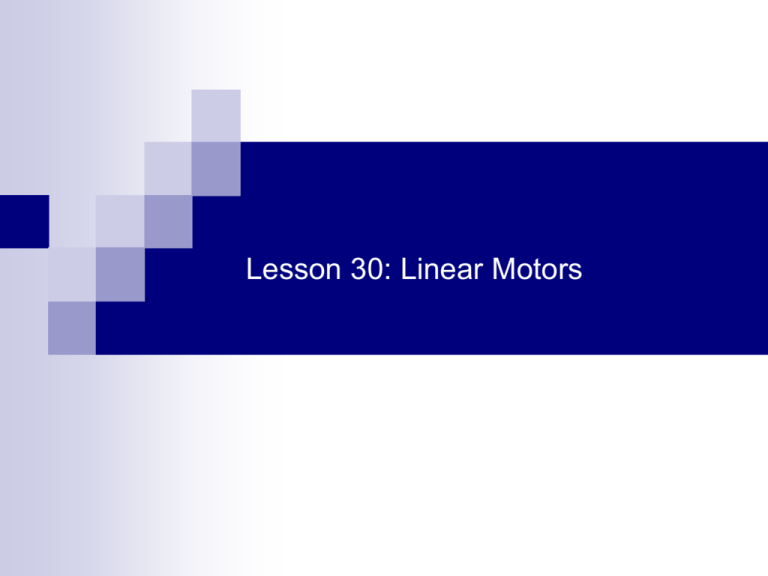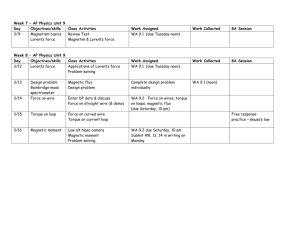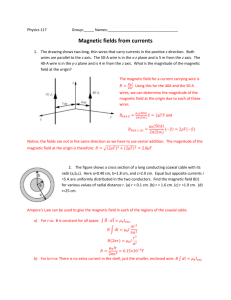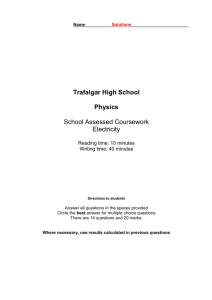EE302 Lesson 1: Introduction
advertisement

Lesson 30: Linear Motors Learning Objectives Explain the difference between permanent magnets and electromagnets. Identify lines of magnetic flux in a permanent magnet, straight line current carrying conductor, and currentcarrying coil. Define flux density, magnetic field intensity, and magnetic flux. Understand the direction of force on a current-carrying conductor in a magnetic field (Lorentz Force Law). Analyze the Lorentz Force Law in a DC linear motor. Understand the effect of a changing magnetic field upon a current-carrying closed path conductor (Faraday/Lenz/Electromotive Force). Linear motors Machines which convert electrical energy into mechanical energy. Magnets Permanent Magnets – Constantly Magnetized (iron, nickel,..) Electromagnets – Exist When Electric Current Is Flowing neodymium rare earth magnet Large electromagnet Magnets All magnets have two poles, north and south. Opposite poles attract, similar poles repel Lines of magnetic flux flow from the north pole to the south pole. Magnetic field is strongest close to the magnet Current Carrying Wire Flowing current produces magnetic field Right-Hand Rule Point right thumb in direction of current flow Finger indicate direction of lines of magnetic flux Current Carrying Coil Current creates magnetic field Closely spaced wires create lines of magnetic flux that reinforce each other and create larger magnetic field Magnetic Flux (Φ) Number of lines between north and south poles Unit of Weber (Wb) (volts-seconds) Magnetic Flux Density (B) Magnitude of magnetic field Unit of Tesla (T), or Weber (Wb) per square meter V sec N Tesla 2 m Am Magnetic Flux (Φ) of a current carrying wire. Same number of lines leaves the pole of the magnet and re-enter the south pole. Lines are denser close to the magnet, especially near the poles. The direction of the lines depends on the direction of the current through the coil. Changing current direction changes the poles of the magnet Higher currents produces more lines of flux Lorentz Force Law Magnetic field created by a current carrying wire interacts with an existing magnetic field to exert a developed force (Fd) on the wire F d I LxB Lorentz Force Law Force is proportional to the current, length of wire, magnitude of magnetic field, and angle between vectors Force is maximum when angle between current and magnetic field is 90 degrees F d I LxB Linear Motor Linear motor consists of current source, moveable wire, and a magnetic field Magnetic field is going into screen Faraday Experiment #2: Motional EMF Moving a conductor through a magnetic field induces a voltage in the conductor. The magnitude of the voltage is proportional to the velocity of the conductor. Faraday’s Law Movement of conductor (wire) in magnetic field induces a voltage Einduced u x B L Induced voltage opposes current from current source VIDEO http://m.youtube.com/watch?v=yGWHdum VCSI http://m.youtube.com/watch?v=FnmetchLOk Linear Motor Startup Initially, applied voltage (VDC) is zero Force on wire is zero Wire is initially at rest Induced voltage across wire is zero Linear Motor Acceleration Voltage source is turned on ->large current begins to flow through wire VDC I Rrail Initial current results in Lorentz force being applied to the bar F d I LxB Bar begins to move and accelerate Linear Motor Operation Voltage is induced in bar as it picks up speed Einduced u x B L KVL equation for circuit becomes VDC – IRrail – Einduced = 0 VDC Einduced I Rrail Linear Motor Operation As speed Einduced I VDC Einduced R current Linear Motor at Steady State If there are no frictional forces (or other loads) on the wire, eventually Einduced will match VDC VDC Einduced I 0 R Zero current will flow through the wire, which means Lorentz force will be zero F d I LxB The machine will maintain a constant speed. This is called STEADY STATE. Linear Motor Operation If frictional forces (or other loads) exist, these can be treated as a force (Fload) that opposes the Lorentz force. When the Lorentz force equals Fload, a steady state condition will be reached, and the bar will maintain a constant speed. Linear Motor Operation The steady state current can be determined: F d I LxB Fload Fload I BL This means the steady state speed can be calculated: VDC Einduced I R Einduced u x B L Eind VDC IRrail u BL BL Example Problem 1 A 100V linear motor operates with a magnetic field of 0.5 Tesla, and a mechanical loading of 1.0N. The effective length of the bar is 0.1m, and the rail resistance is 0.02 Ω. Find the current flowing through the motor and the velocity of the bar. Power Balance Ploss I 2 Rrail PIN VDC I Pout Fload u Eind I Example #2 Design a 10 kW (output power) roller coaster that reaches 100 km/hr. Maximum B-field is 3 T. We have a 450 V DC source available. Desired efficiency is 95%. Find the required rail resistance, source current, and bar length. Bottom Line F = ILB Force (Newtons) = Current (amps) *Length (meters) * B-field (Tesla) E = uBL Induced voltage = velocity of bar (meters/sec) *B*L Take givens, draw what you know on the single loop model. Use, P = VI, V=IR, KVL around loop … that’s all you need to solve these types of problems. Two important laws to remember (and not confuse) Faraday’s law: Movement of conductor (wire) in magnetic field induces a voltage Lorentz Force Law: a force will be exerted on a current carrying conductor when it is placed in a magnetic field.








